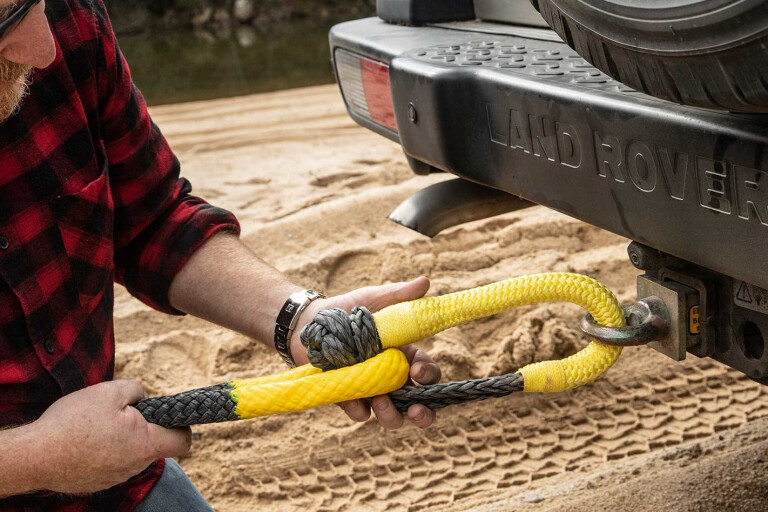
THE SNATCH strap has been the go-to recovery device for four-wheel drivers for many years – so long as you have another vehicle on hand, a snatch strap is usually the easiest and fastest way to recover a stuck vehicle. But now there’s a new kid on the block that promises to offer all the benefits of a snatch strap but with greater safety, longevity and effectiveness. Enter the kinetic recovery rope.
They haven’t been around for long, but you’ve probably seen kinetic recovery ropes advertised online or even out in the field. Several reputable 4x4 accessory companies already offer versions of this new recovery device, and other big players in the market will no doubt soon have their own branded versions.
But what makes kinetic recovery ropes better than traditional snatch straps? And are the benefits enough to justify the premium price tags, which can be twice as much (or more) than a traditional snatch strap?
Some nine-metre-long kinetic recovery ropes retail for up to $350, which is a helluva lot more than an 8000kg snatch strap that sells for $40, but the extra investment not only buys you greater capacity and longevity, but also more stretch, which can make recovering stuck vehicles both easier and safer.
How do kinetic recovery ropes work?
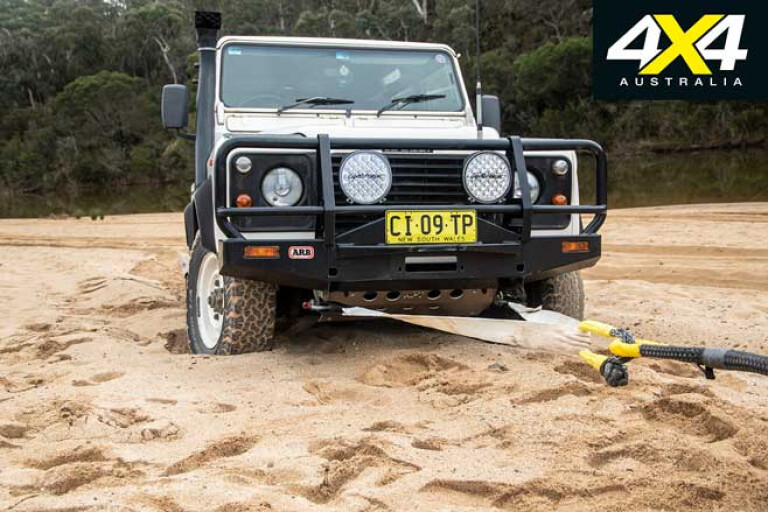
THE principle behind a vehicle recovery using a kinetic recovery rope is the same as a traditional snatch strap. The vehicle being recovered is pulled out of its predicament by another vehicle using the stretchy kinetic recovery rope.
The rope is attached to both vehicles (using rated shackles attached to rated recovery points), then the recovery vehicle gets a run-up and pulls on the rope, which stretches like an elastic band and then contracts, using the stored kinetic energy in the rope to hopefully yank the stuck vehicle out of its bogged state.
Of course, this kind of recovery can only be performed if there are at least two vehicles on hand, and if there’s enough space available for the recovery vehicle to get a good run-up. Additionally, this recovery method should only be employed if the recovery can be performed by pulling the stuck vehicle forwards or backwards, not to either side.

The big difference in how a traditional snatch strap works compared to a kinetic recovery rope is the latter’s additional stretchability. Recovery ropes are claimed to stretch by as much as 30 per cent during a vehicle recovery compared with around 20 per cent for a traditional snatch strap. This results in decreased shock loads on vehicles.
“With standard snatch straps, they only stretch about 20 per cent, whereas you’ll get up around that 30 per cent stretch with kinetic ropes,” says Ryan Rose from Sherpa 4x4. “What that means is when you recover a vehicle there’s a much softer impact.”
There are obvious benefits to having reduced shock loads during a recovery operation, with less strain on the recovery equipment itself as well as less strain on the vehicles involved.
What are traditional snatch straps
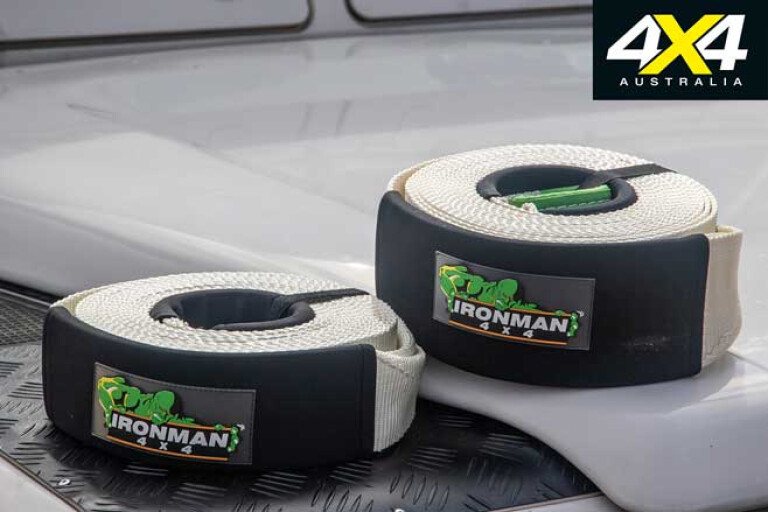
TRADITIONAL snatch straps are manufactured from flat nylon webbing and are available in different lengths, widths and capacities. Nine-metre lengths and minimum breaking strengths between 8000 and 11,000kg, with widths between 60 and 100mm, are popular choices for four-wheel drivers.
It’s advisable that the snatch strap’s minimum breaking strength should be between two- to three-times the Gross Vehicle Mass (GVM) of the lightest of the two vehicles involved in the recovery operation.
Snatch straps typically have reinforced eyes at each end to allow fitment of rated shackles for vehicle attachment. To form these eyes, the nylon webbing is looped back onto itself and is stitched together.
Despite the eyes of a snatch strap being reinforced and the stitched areas usually covered by seam-protector sleeves, it is this area of the snatch strap that is the weakest point and therefore most prone to failure on an otherwise undamaged strap.
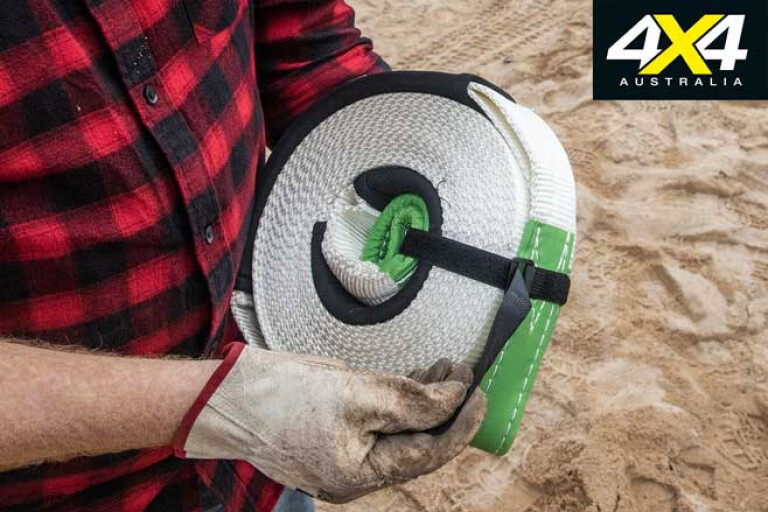
Vehicle recoveries are performed on a variety of surfaces, and often this can cause significant damage to the unprotected webbing of a snatch strap; which can be nicked or cut on sharp rocks or other obstacles, simply worn on sandstone and the like, or even damaged when inadvertently run over by a vehicle.
If a snatch strap shows signs of obvious damage, it should be retired from service because a failure could be imminent, which could result in damage to vehicles or injury to people.
What are kinetic recovery ropes

KINETIC recovery ropes are also manufactured from nylon, but in the form of a double-braided rope. The inner nylon core is the stretchy component, and this is protected by a braided nylon outer layer.
“The outer layer is also made from nylon, but it’s a polyamide, a nylon 66 polyamide,” explains Adam Craze from Ironman 4x4. “The outer layer is double-braided and it’s coated to give it resistance to abrasion. While the outer layer also has a bit of stretch, it essentially provides strength to the stretchy core and acts as an outer sheath.”
It’s this abrasion-resistant outer layer that gives kinetic recovery ropes a big advantage over traditional snatch straps, which don’t have any protection over their stretchy nylon webbing.
Another big advantage is the way in which the looped ends (the eyes) of a kinetic recovery rope are formed. These ends are spliced together rather than stitched, eliminating the weakest point of a snatch strap.
“Kinetic recovery ropes don’t have any stitching, which takes away that potential failure point,” says Adam Craze. “After a few uses, people forget to check their straps and how many times they’ve been used. Sooner or later a snatch strap will break down. Kinetic recovery ropes will last a lot longer and, like I said, they don’t have that failure point at the stitching, where a snatch strap’s webbing is stitched together.”
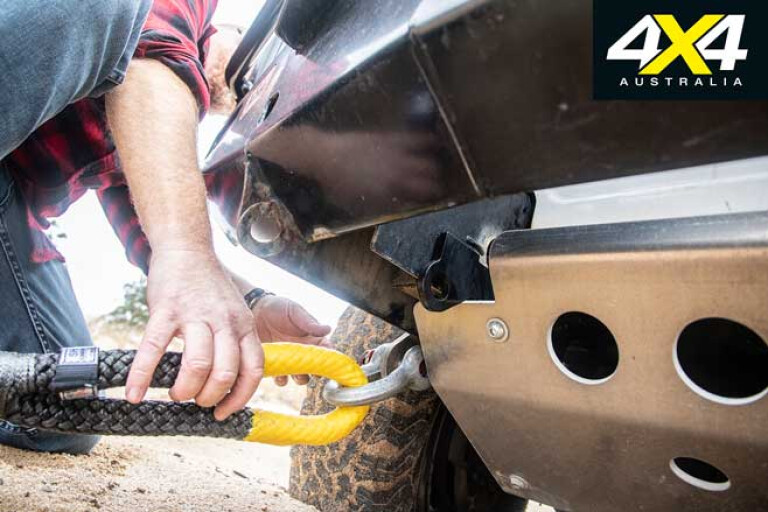
Thanks to their double-braided layer construction, there’s no need for the looped ends of a kinetic recovery rope to be reinforced, but most will feature a polyurethane (PU) coating to minimise the occurrence of wear at the point where the rope attaches to a rated shackle.
Just about all of the kinetic recovery ropes we’ve seen have a claimed 30 per cent stretch, which is a substantial 50 per cent greater than the 20 per cent stretch that most traditional snatch-strap manufacturers claim.
As outlined earlier by Sherpa 4x4’s Ryan Rose, this extra stretch results in decreased shock loads on vehicle recovery points and shackles when performing a snatch recovery, which is obviously beneficial for the vehicles involved as well as for overall safety during a vehicle recovery, as there’s less chance of component failure.
Higher rating
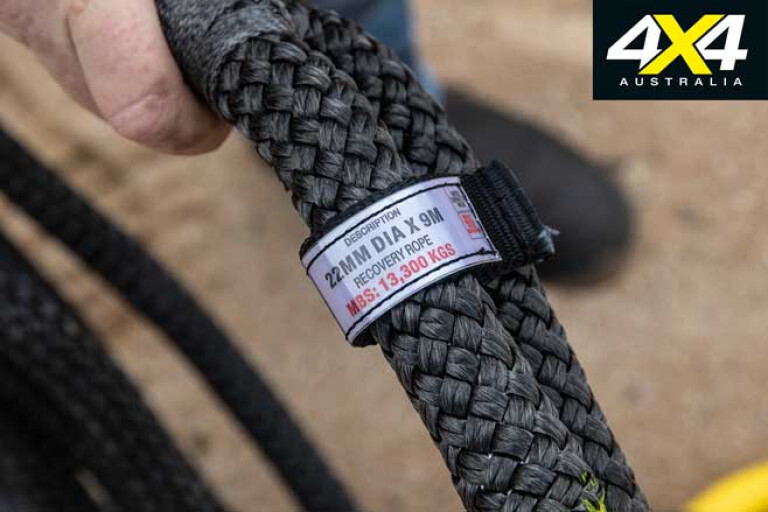
WE TESTED two kinetic recovery ropes for this story. Ironman 4x4 supplied its 9500kg rope and Sherpa 4x4 supplied its 13,300kg rope. Both of these have higher minimum breaking strengths than popular 8000kg snatch straps, but as Ironman 4x4’s Adam Craze explains, that’s really just a sign of the times.
“Vehicles are getting heavier these days and people are loading them up,” explains Adam. “With the extra stretch and the smoothness of the kinetic rope, it can still be used to recover lighter vehicles with a gentle pull but, with heavier and heavier vehicles, you want the higher rating. Many vehicles are up over three tonnes these days, so we think 9500kg is a good place to be.”
Sherpa 4x4’s Ryan Rose agrees and points out that the higher ratings will also have longevity benefits. “They’re rated a lot higher,” he says, “so with normal snatch straps you’re much closer to their breaking limit … everyone’s had a snatch strap break, whereas I personally have never had a kinetic rope break.”
As a result of these higher ratings and their different construction, kinetic recovery ropes are generally slightly heavier than traditional snatch straps, but not by much. For example, Ironman 4x4’s 8000kg snatch strap weighs 2.23kg and its 11,000kg snatch strap weighs 2.86kg.
By contrast, an Ironman 4x4 9500kg kinetic recovery rope weighs 3.18kg in its carry bag, and the Sherpa 4x4 13,300kg kinetic recovery rope weighs 4.74kg in its carry bag.
Other benefits of kinetic recovery ropes
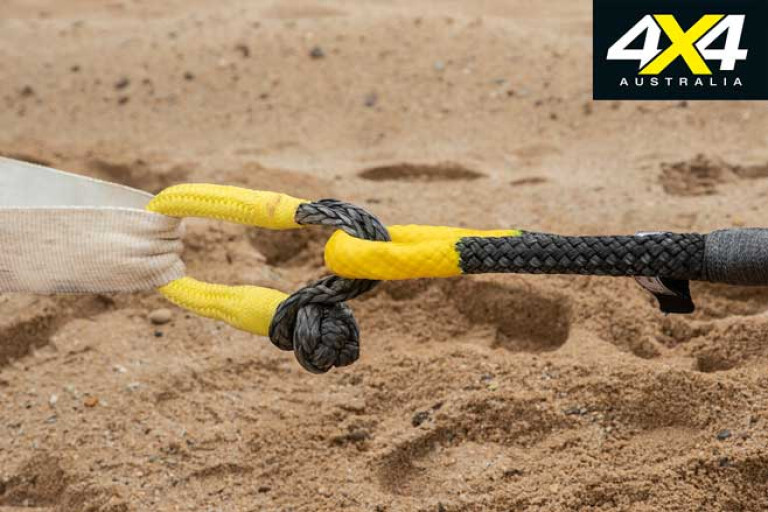
SNATCH straps should be neatly rolled up after use to prevent kinking as the unprotected nylon webbing is prone to damage if not stowed properly, but kinetic recovery ropes can be simply placed into a bag when you’ve finished with them, making handling a much simpler affair. And most kinetic recovery ropes are supplied with a ventilated carry bag (with mesh sections) to allow them to dry if stowed when wet.
“You can just bundle it up and throw it in the bag,” says Adam Craze of the Ironman 4x4 9500kg rope, “whereas most of us roll up our snatch straps and tuck them in somewhere safe. And it’s handy having a bag for a kinetic recovery rope; if it’s wet, the bag is basically open mesh, so it can air out and dry while it’s in the bag.”
Kinetic recovery rope care and maintenance procedures are essentially the same as with a snatch strap, so if muddy it should be hosed clean and allowed to dry; this will minimise the risk of abrasive dirt particles working their way between the nylon braiding and causing premature wear.
It should be pointed out that, just like traditional snatch straps, not all kinetic recovery ropes are created equal. While researching for this story we discovered plenty of ropes for sale online for as little as $120 delivered, but as with all recovery equipment we’d advise against going for the cheap option.
The Ironman 4x4 9500kg rope we tested for this story, for example, retails for $165 and it has been thoroughly tested to ensure it does exactly what it says on the box. “We’ve done a lot of development and testing,” says Adam Craze. “We went through several different versions, several different outer coatings, to try to find a stronger outer coating, and to make sure it does what it’s designed to do. We’ve spent a fair bit of time on development, with testing in the real world and in a NATA (National Association of Testing Authorities, Australia) testing lab, so we can verify everything that we build.”
Recovery points and shackles
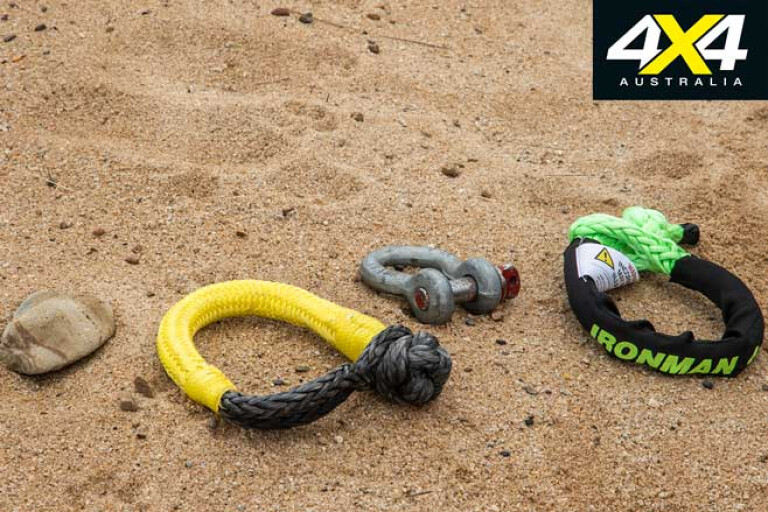
THE looped ends of kinetic recovery ropes are thicker than equivalent traditional snatch straps, so you won’t be able to feed one through a two-inch hitch receiver and use the pin as a recovery point. Instead, you’ll need a dedicated recovery hitch, either fitted with a rated steel shackle or a soft shackle.
If using soft shackles, it’s preferable that the vehicles’ rated recovery points have no sharp edges that could otherwise damage the shackle, even if fitted with an abrasion-resistant sleeve. Soft shackles offer several benefits over traditional steel D-shackles and bow shackles: they are lighter, they float and they are unlikely to cause injury if there’s an equipment failure. Soft shackles can also be used to connect two snatch straps together, whereas a steel shackle should never be used for this purpose.
“We’re always looking for safer and smarter products,” says Adam Craze. “Combining kinetic recovery ropes and soft shackles is a great example of this.”
Kinetic recovery ropes tested

TO VALIDATE the “stretchy” claims made by kinetic rope manufacturers, 4X4 Australia Deputy Editor Justin Walker and I decided to pitch two ropes against two traditional snatch straps. So we found some soft sand, intentionally bogged my Defender and snatched it out using the straps and then the ropes with JW’s Discovery.
Ironically, getting intentionally bogged is always more difficult than becoming accidentally bogged, but on-road tyre pressures, low-range first gear, some super-soft sand and a boot-full of revs soon had the Defender buried.
First up we snatched the Defender out using a new Ironman 4x4 8000kg snatch strap, followed by a new 11,000kg strap. We then trialled the Ironman 4x4 9500kg kinetic recovery rope and the Sherpa 4x4 13,300kg kinetic recovery rope.
The snatch straps worked as predicted, quickly heaving the Defender out of the soft sand with a decent jolt. While the end result was the same using the kinetic ropes, the recovery certainly felt smoother as a result of the extra stretch, even with the heavier duty Sherpa 4x4 rope.
One of the most noticeable benefits of the kinetic recovery ropes was stowing them after use; we just bundled them into their respective bags and threw them in the back of the vehicle. With the snatch straps, we had to roll them up and secure them with the supplied Velcro straps to prevent them from unfurling.
Are kinetic recovery ropes worth it?
Are kinetic recovery ropes better than traditional snatch straps? Yes. Are they worth the extra purchase price? Definitely.
Not only are kinetic recovery ropes more durable than snatch straps, they are also less prone to failure and way more convenient when it comes to packing away after use. Of greater importance, however, they provide a “softer” snatch recovery, which is easier on recovery gear, easier on vehicles and inherently safer.

COMMENTS